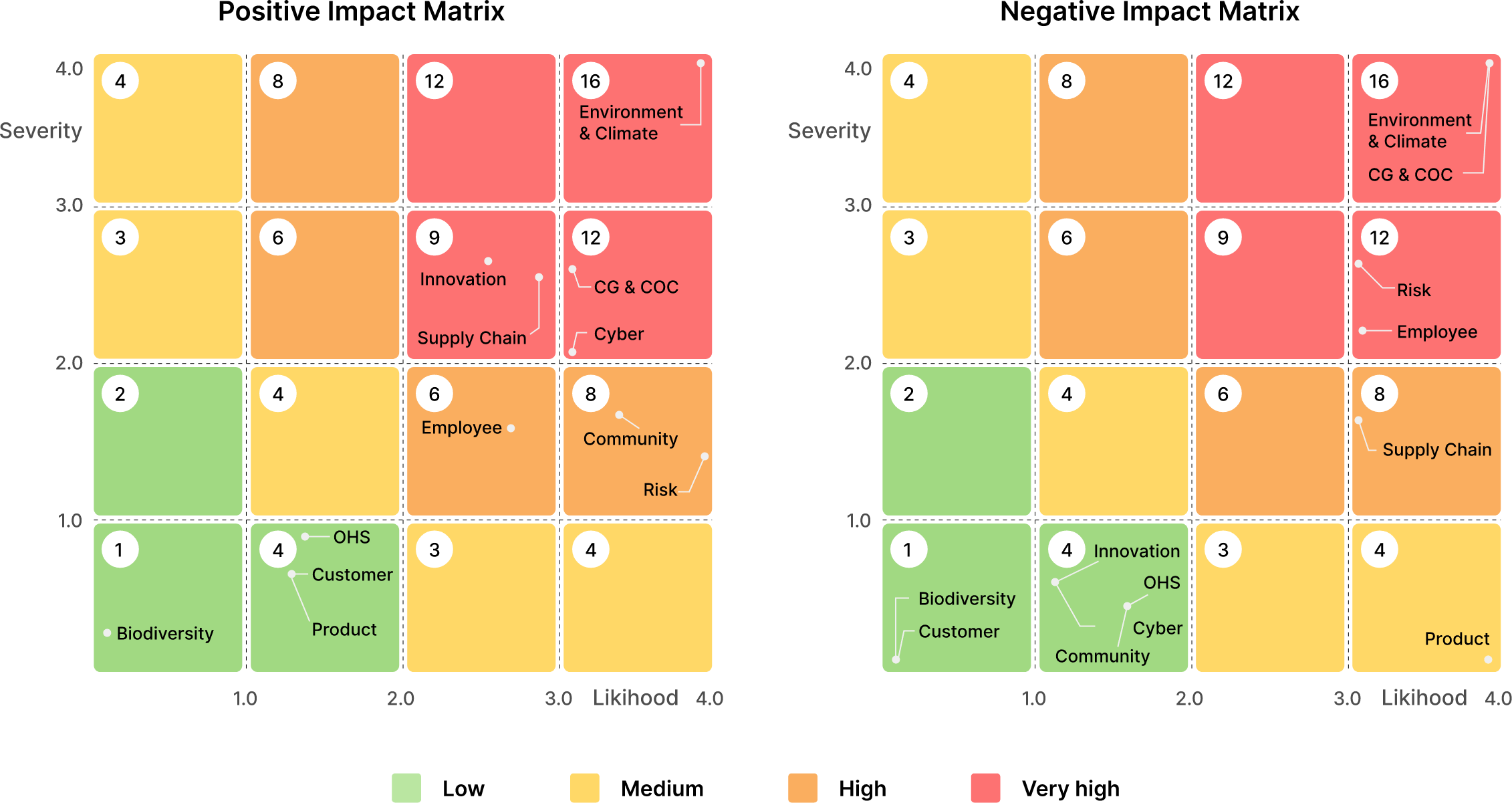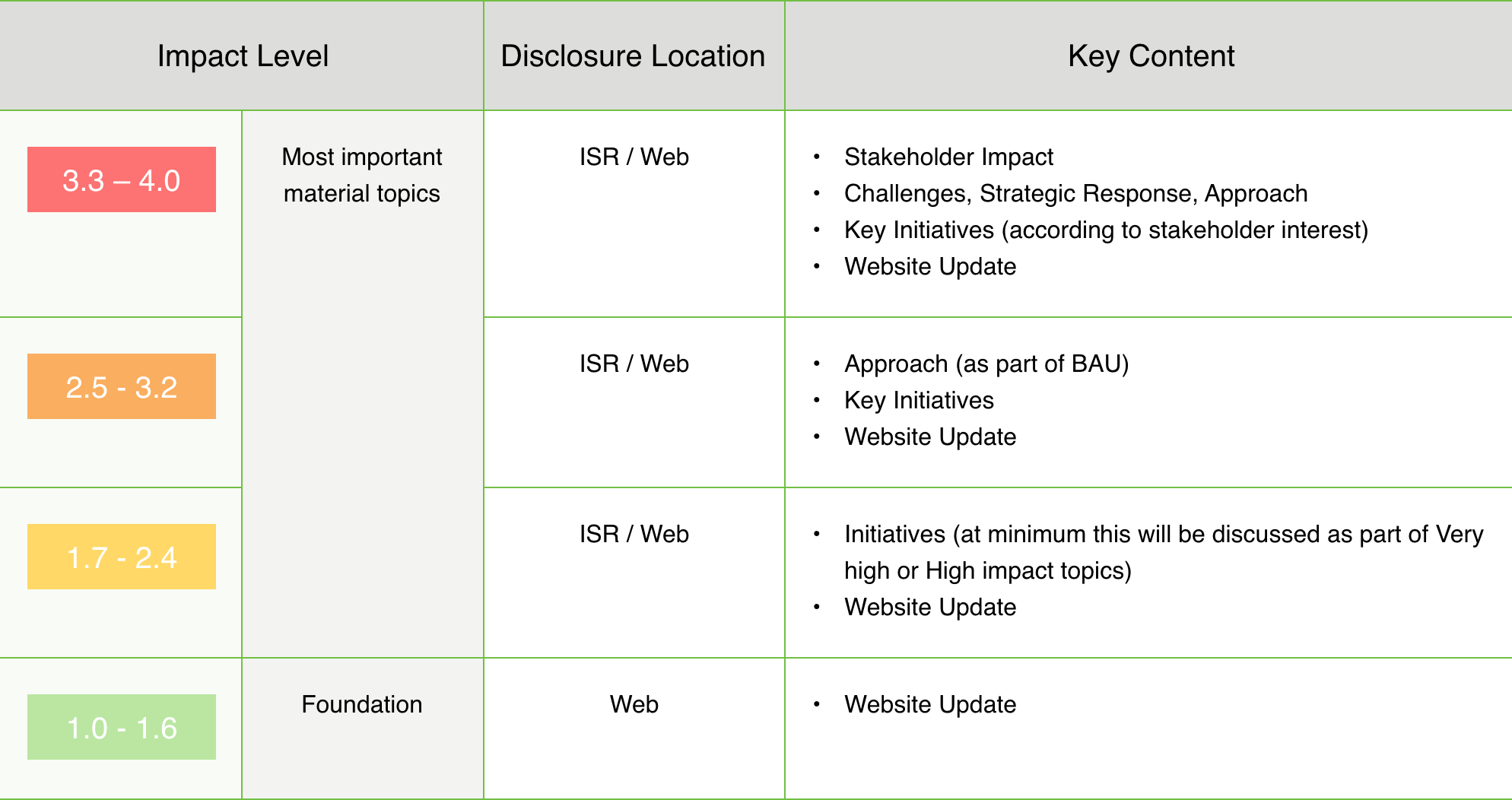
Materiality Topics
Materiality Assessment Process GRI 3-1 (2021)
GGC developed our Integrated Sustainability Report by selecting and assessing materiality topics that are material to the development of GGC’s sustainability along with materiality topics that are consistent with stakeholder expectations. GGC’s Integrated Sustainability Report follows guidance according to the Global Reporting Initiative (GRI) Standards 2021, the Integrated Reporting (IR) Framework by the International Integrated Reporting Council (IIRC), and the Taskforce on Climate-related Financial Disclosures (TCFD) framework. The report also follows the annual Form 56-1 One Report guideline. By following the aforementioned standards, the prioritization of materiality topics follows the outlined of GRI Standards which comprises 4 steps detailed as follows:
GGC consolidated information related to business operations across the value chain including both internal and external information in the context of sustainability through the economic, social, and environmental dimensions. Information is collected from engagements with stakeholders and experts, researching trends in response to global issues and industry trends as well as comparisons of the company’s strategic direction and challenges with the UN Sustainable Development Goals. In addition, GGC also consistently conducts interviews with various stakeholder groups to better understand the context around our operations. An assessment or a review of identifying material issues will be conducted every year to identify key issues, changes, and the impact that may affect the Company in a timely manner.
GGC engaged and conducted interviews with 6 stakeholder groups including shareholders, investors & analysts, communities & society, government agencies, employees, business partners, customers, and industry experts to discuss concerns and expectations related to positive and negative impacts that may arise from material topics which range from economic, social and environmental topics. This also includes human rights impacts on stakeholders and business risks and opportunities that may arise from internal and external factors within the value chain. The analysis and identifying of these materiality topics were in accordance with the Double Materiality preparation, which supports the Company in its identification of both external impacts on the organization and the impacts of the organization on the external world.
Understanding these impacts allows GGC to prepare and respond to negative impacts while creating positive impacts throughout our operations.
After the identification of material topics in Step 2, GGC collects stakeholder and expert opinions to assess the positive and negative impacts on the economy, society, environment, and human rights in terms of the possibility of those impacts occurring (likelihood) and the severity of those impacts (severity). In determining the severity of impacts, the scale and scope of the impact are assessed, for example, the widespread of the impacts and the number of people that got affected by the impacts. For negative impacts, the ability to mitigate and remediate the impact (remendability) of the impact is also assessed.

Assessment results from Step 3 are used to prioritize GGC’s material topics where the results are tested through a comparison against global perception trends on the importance of various international issues. Results of the Company’s assessment for significance are presented in terms of their relation to the organizational context, targets, and strategy. The selection and disclosure of material topics and related content in GGC’s Integrated Sustainability Report 2024 were approved to disclose and report by the Sustainable Development Committee, the Executive Committee, and the Corporate Governance Committee. The prioritization of the materiality is incorporated into company’s overall enterprise risk management process discussion (ERM). Furthermore, to ensure the transparency, clarity, and validity of the disclosed information, the materiality assessment process, stakeholder engagement process, and data collection and evaluation process have been verified by an external third-party verifier. The verification results can be found in the Appendix of this report.
Report Content Defining Process

Material Topics and Management of Material Topics GRI 3-3 (2021)
Impact to Company
Type of Impact : Positive
- Increase efficiency and raise the level of capability in business operations and business competition, as well as attracting the attention of investors
- Ready to deal with risks and be able to mitigate the impact of various risks in an efficient and timely manner.
Type of Impact : Negative
- Business Conducts Violation can reduce efficiency in business competition and investor confidence. As a result, investors’ interest in GGC will decrease.
- Increase the risk of violations of regulations, laws and human rights.
Impact to External Stakeholders
Type of Impact : Positive
- Stakeholders receive compensation and fair treatment. Human rights and labor rights were not violated or being taken advantage of.
- Reduce damage from legal violations, as well as Human rights and labor violations, enabling stakeholders to efficiently achieve their own policy goals.
- Stakeholders receive fair and effective relief and compensation for the impacts of risks.
Type of Impact : Negative
- Stakeholders receive unfair compensation and treatment, which brings about the issue of violating the law, Human rights and labor
- Damage caused by legal violations Human rights and labor makes stakeholders unable to achieve the organization’s business goals
- Stakeholders are severely affected by ineffective risk management. and did not receive proper remediation.
Impact Level
Impact Boundary, Key Stakeholders and Human Rights
Within Organization
Outside Organization
Management Approach and Key Initiatives
ISR:
- Corporate Governance
- Business Ethics
- Risk Management
GRI
SDGs
Impact to Company
Type of Impact : Positive
- Increase efficiency in the production process of environmentally friendly products By developing low carbon products, making up 50% of total products in 2024
- Increase the capacity of resource and energy management, as well as increase the use of renewable energy. Raising standards for producing low carbon products. As a result, the amount of greenhouse gas emissions has decreased by 3,802 tons Carbon dioxide equivalent per year and help save costs of more than 3.31 million THB.
Type of Impact : Negative
- Climate change could affect the acquisition of agricultural raw materials, with a price increase of 14% for oil palm. It may also affect production and may lead to interruptions in the production process.
- The amount of energy used and the amount of garbage and waste increase due to inefficient management. This makes it impossible to achieve the goal of reducing greenhouse gas emissions in both the short and long term and affects the credibility of the organization.
- Damaged from violating laws, regulations, and environmental measures
Impact to External Stakeholders
Type of Impact : Positive
- Reduce environmental impacts on society and nearby communities from the decreased amount of greenhouse gas emissions and reduced amount of trash and waste.
- Stakeholders receive support in issuing policies or climate change measures and be able to effectively achieve environmental performance and climate management goals.
- Respond to the demand for environmentally friendly products.
Type of Impact : Negative
- Farmers face problems from climate change, affecting the quality of the product and causing a decrease in production numbers.
- Violation of human rights and the wellbeing of people in the surrounding communities from the amount of garbage, waste, and pollutants that are emitted
Impact Level
Impact Boundary, Key Stakeholders and Human Rights
Within Organization
Outside Organization
Management Approach and Key Initiatives
ISR:
- Operational Excellence
- Sustainable Product (Growth-Portfolio)
- Carbon sequestration and offsetting (Compensation)
GRI
- GRI 305 Emission 2016: SOx, NOx and other significant air emissions (GRI 305-7)
- GRI 303 Water and Effluent 2018: Water Withdrawal (GRI 303-3), Water Discharge (GRI 303-4), Water Consumption (GRI 303-5)
- GRI 306 Waste 2020: Waste Generated (GRI 306-3), Waste Diverted from Disposal (GRI 306-4), Waste Directed to Disposal (GRI 306-5)
- GRI 302 Energy 2016: Energy Consumption within the organization (GRI 302-1), Total energy consumption outside the organization (GRI 302-2); Energy intensity (GRI 302-3)
- GRI 305 Emissions 2016: Direct (Scope 1) GHG Emissions (GRI 305-1), Energy Indirect (Scope 2) GHG Emissions (GRI 305-2), Other Indirect (Scope 3) GHG Emission (GRI 305-3)
SDGs
Impact to Company
Type of Impact : Positive
- Increase efficiency of the Business Continuous Plan (BCP) to reduce the risk of damage to GGC’s reputation and credibility, as well as operational risks that will affect GGC’s operating results.
- Able to cope with changes from both short- term and long- term risks efficiently and in a timely manner.
Type of Impact : Negative
- Damage to the image and business performance of GGC, which may lead to failure in business operations due to being unable to cope with changes and impacts from risks.
Impact to External Stakeholders
Type of Impact : Positive
- Reduce problems that may occur to stakeholders from operational risks and climate change risks from an effective risk management plan that covers all groups of relevant stakeholders.
- Increase planning skills to solve problems and decision making through organizing training and preparation for stakeholders.
Type of Impact : Negative
- Decreased operating results of GGC due to inefficient risk management. This results in lower financial returns for investors and affects returns to other stakeholders throughout the supply chain.
- Fluctuations in raw material prices and product prices due to failure to mange risks. As a result, customers do not receive quality products and may lead to violations of human rights and labor in various issues.
Impact Level
Impact Boundary, Key Stakeholders and Human Rights
Within Organization
Outside Organization
Management Approach and Key Initiatives
GRI
SDGs
Impact to Company
Type of Impact : Positive
- Products of GGC that received a Carbon Footprint Reduction Label (CFR) or Global Warming Reduction Label make up more than 28 percent of all products which can reduce greenhouse gas emissions by more than 52,561 tons of carbon dioxide equivalent.
- Increase the number of GGC’s low carbon products to reduce the GHG Emissions from production and usage of products.
Impact to External Stakeholders
Type of Impact : Positive
- Respond to government policies, measures, and requirements. As a result, the country will achieve the specified goals and be accepted internationally.
- Respond to customers’ demands for environmentally friendly products.
- Reduce environmental problems resulting from business operations in the community and surrounding society.
- Promote and enhance innovation skills through offering, investing, and researching low-carbon products, enabling the push forward to create learning for the oleochemical industry in Thailand.
Impact Level
Impact Boundary, Key Stakeholders and Human Rights
Within Organization
Outside Organization
Management Approach and Key Initiatives
GRI
SDGs
Impact to Company
Type of Impact : Positive
- Increase efficiency in GGC’s business operations driven by potential employees.
- GGC can grow steadily and sustainably by attracting and retaining efficient employees.
Type of Impact : Negative
- GGC loses its reputation. This results in an inability to attract and retain knowledgeable and talented personnel.
- GGC’s operating results decrease from the decreased ability to conduct business due to a shortage of potential employees.
- GGC’s lack of knowledge development, causing GGC to lag behind and lack the ability to compete.
Impact to External Stakeholders
Type of Impact : Positive
- Promote employee well-being, including receiving fair compensation as well as various benefits for both the employee and their families.
- Employee receive support in developing their skills, knowledge and abilities, which enables efficient work
- Increase the level of engagement of stakeholders towards GGC, which is an important part in
Type of Impact : Negative
- Brings up issues of human rights and labor violations from employment and receiving unfair compensation.
- Employees do not receive training to develop the skills necessary to perform their jobs, resulting in work being less efficient and not in line with GGC’s expectations.
- Lower returns for investors because GGC lacks personnel with knowledge and ability to help promote operations.
Impact Level
Impact Boundary, Key Stakeholders and Human Rights
Within Organization
Outside Organization
Management Approach and Key Initiatives
ISR:
- Employee Development
- Employee Retention
- Employee Attraction
- Employee Recruitment
GRI
- GRI 405 Diversity and Equal Opportunity 2016: Ratio of basis salary and remuneration (GRI 405-2)
- GRI 2 General Disclosure 2021 (GRI 2-7)
SDGs
Impact to Company
Type of Impact : Positive
- Increase efficiency in GGC’s operations by selecting business partners and effective suppliers and adhering to the principles of sustainability.
- Reduce production costs by encouraging suppliers to operate under sustainability principles.
- Increase the potential to deliver raw materials, which promotes continuity of product delivery.
Type of Impact : Negative
- Reduces reliability and loss of reputation from violating the law, human rights, and labor, as well as creating environmental impacts from inefficient raw material acquisition and procurement processes
Impact to External Stakeholders
Type of Impact : Positive
- Educate farmers in Thailand on sustainable palm cultivation, which increases the potential of Thai farmers, reduces deforestation, and reduces the impact of human rights risks that may occur from palm oil plantations and other agricultural raw materials.
Type of Impact : Negative
- Increase the impact of deforestation and unsustainable resource management. This results in a shortage of natural resources and damages the diversity of the ecosystem. This stems from the failure to communicate the Supplier Code of Conduct
Impact Level
Impact Boundary, Key Stakeholders and Human Rights
Within Organization
Outside Organization
Management Approach and Key Initiatives
ISR:
- Sustainability-Related Risks Management
- Raw Materials Management
- Logistics and Warehouse Management
URL:
GRI
- GRI 308 Supplier Environmental Assessment 2016: Disclosure GRI 308-1 New suppliers that were screened using environmental criteria
- GRI 414 Suppliers Social Assessment 2016: Disclosure GRI 414-1 New Suppliers that were screened using social criteria
SDGs
Impact to Company
Type of Impact : Positive
- Increase investment in research and development, which leads to product quality development. This helps increase the value of GGC’s products and build business competitiveness. GGC’s investment in product research and development is worth 3.96 million THB
- Promote the research and development of innovative processes, which can enhance efficiency in using resources for maximum benefit, as well as reduce pollution emissions and reduce greenhouse gas emissions into the environment.
Type of Impact : Negative
- Loss of Business Competitiveness, which causes a loss of market share to competitors from the delayed response to innovation changes.
Impact to External Stakeholders
Type of Impact : Positive
- Product prices decrease, while quality increases.
- Employees develop knowledge and innovation skills that are beneficial to improving product quality.
- Partners and customers develop innovations together with GGC, which leads to economic, social and environmental development of the country.
- Shareholders receive more returns from the development and application of innovations.
Type of Impact : Negative
- Product quality does not meet customer needs. As a result, investors’ earnings will decrease.
- Reduce efficiency in making maximum use of raw materials, which may cause problems in the use of natural resources.
Impact Level
Impact Boundary, Key Stakeholders and Human Rights
Within Organization
Outside Organization
Management Approach and Key Initiatives
GRI
SDGs
Impact to Company
Type of Impact : Positive
- Reduce damage from personal data violation issues and identity theft. This helps increase the credibility of GGC and help build competitive capabilities
Type of Impact : Negative
- Information leaks causing damage to GGC’s operations, as well as increasing expenses from compensation for data leaks.
Impact to External Stakeholders
Type of Impact : Positive
- Maintain personal information of all stakeholder groups. This helps build confidence in working with GGC.
Type of Impact : Negative
- Leads to issues of violation of human rights and loss of the trust of stakeholders from the personal information leak.
Impact Level
Impact Boundary, Key Stakeholders and Human Rights
Within Organization
Outside Organization
Management Approach and Key Initiatives
ISR:
- Operational Excellence
- Logistics and Warehouse Management
GRI
SDGs
Impact to Company
Type of Impact : Positive
- Receive complaints about operations that do not take into account the needs of the community and society, which leads to GGC losing credibility.
Impact to External Stakeholders
Type of Impact : Positive
- Leads to violation of human rights and creates negative impacts on the living conditions of the community
Impact Level
Impact Boundary, Key Stakeholders and Human Rights
Within Organization
Outside Organization
Management Approach and Key Initiatives
GRI
- GRI 201 Economic Performance 2016: Community Investment (GRI 201-1)
SDGs
Impact to Company
Type of Impact : Positive
- Increase opportunities to expand business with customers.
Impact to External Stakeholders
Type of Impact : Positive
- Respond to customer needs
Impact Level
Impact Boundary, Key Stakeholders and Human Rights
Within Organization
Outside Organization
Management Approach and Key Initiatives
GRI
SDGs
Impact to Company
Type of Impact : Positive
- Reduce the risk of deforestation in GGC’s raw materials acquisition, which helps reduce environmental impacts.
Impact to External Stakeholders
Type of Impact : Positive
- Forests and natural resources have been restored, which increases biodiversity.
- Increase agricultural production from the restoration of nature and ecosystems
Impact Level
Impact Boundary, Key Stakeholders and Human Rights
Within Organization
Outside Organization
Management Approach and Key Initiatives
ISR:
- Carbon sequestration and offsetting (Compensation)
GRI
SDGs
Impact to Company
Type of Impact : Positive
- Reduce the number of accidents that occur within the workplace and create a better working environment, which enables continuous business operations.
Type of Impact : Negative
- In case of accident or the death of employee or related personnel while working, this may cause disruption to operations and impact the reputation of GGC.
Impact to External Stakeholders
Type of Impact : Positive
- Help reduce accidents that may occur among employees and suppliers during work, which reduces the risk of human and labour rights violations
Type of Impact : Negative
- May cause disability of employees that affects the employees’ families lead to a difficult life.
Impact Level
Impact Boundary, Key Stakeholders and Human Rights
Within Organization
Outside Organization
Management Approach and Key Initiatives
GRI
- GRI 403 OHS 2018: Work Related injuries (GRI 403-9), Works Related Ill health (GRI 403-10)
- Number of process event safety (OGSS OG13), to be replaced by GRI 306 Waste 2016 (GRI 306-3) which is topic standard disclosure for 2021 O&G Sector Standard Ref.No.11.8.3
SDGs
Sample of Management of Significant Material Topics
| Material Issues | Corporate risk factor | Targets and Progress | Corporate KPI* | References |
|---|---|---|---|---|
| Climate Strategy and Energy Management | Strategic Risk: Climate Action Towards Net Zero Risk |
|
|
Climate Strategy Energy Management |
| Supply Chain Management – RSPO |
Operational Risk Factors: Price quality risk factor and availability of agricultural raw materials Reputational Risk Factors: The risk of losing the Company's good reputation from procurement of raw materials that cause damage to the environment and society |
|
|
ISR
|
| Occupational Health and Safety | Business as Usual Risk: Operational and Safety Risk |
|
|
Occupational health and safety management |
*Remark: The Corporate KPI is accounted to 70% of Executive Individual KPIs
Fore more information, see: GGC Materiality External Impact Valuation 2024





